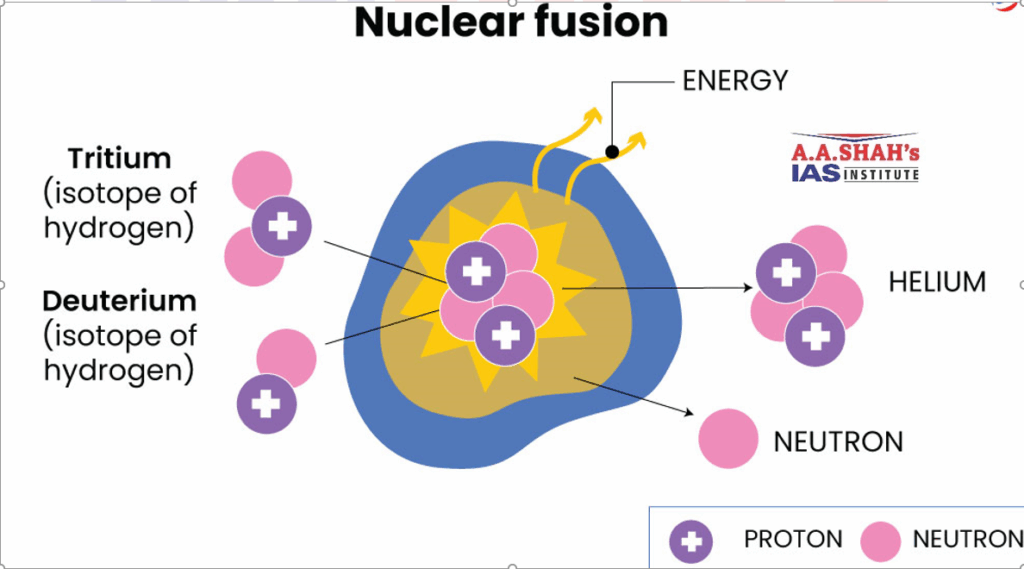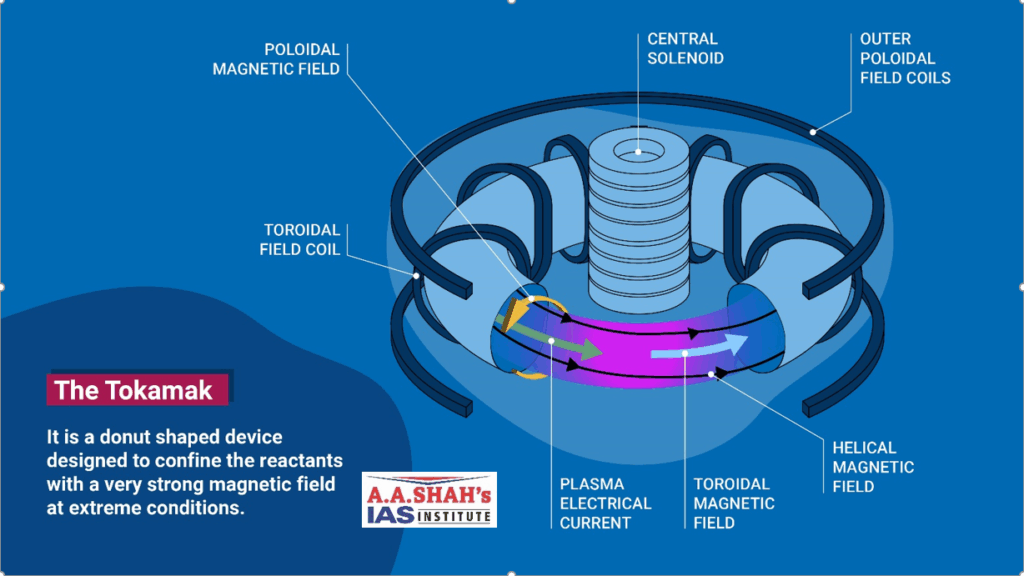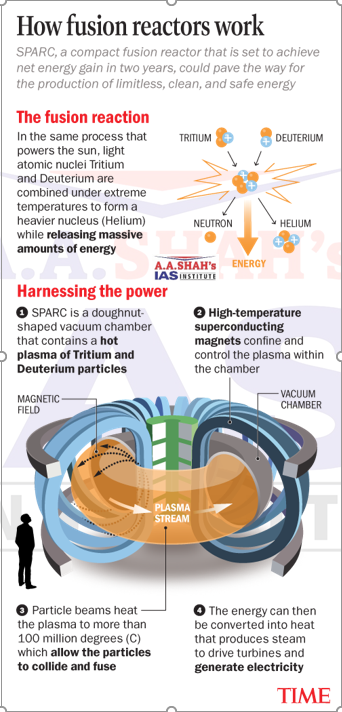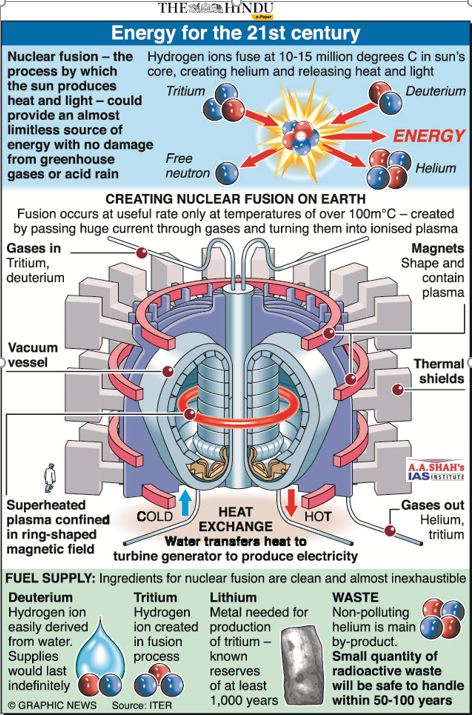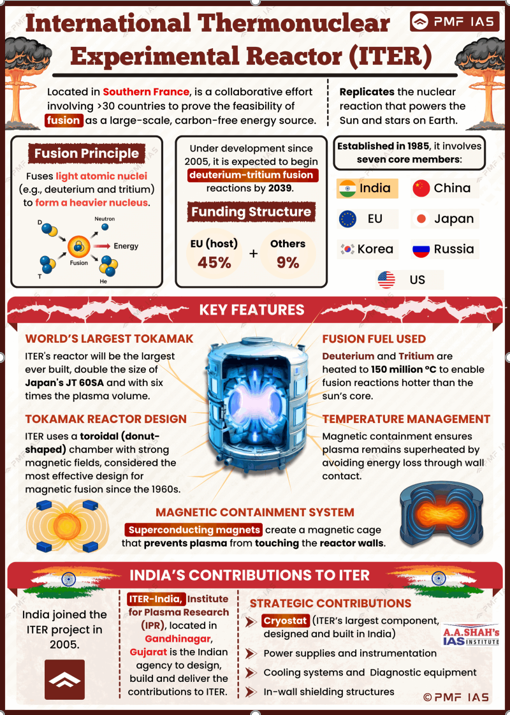IPR Gandhinagar proposes roadmap for India’s fusion power plans
S&T – ENERGY
24 SEPTEMBER 2025
Steady-state Superconducting Tokamak-Bharat (SST-Bharat),
- Researchers at the Institute for Plasma Research (IPR) in Gandhinagar have laid out a roadmap for India to achieve fusion power.
- They envisage developing India’s first fusion electricity generator, called the Steady-state Superconducting Tokamak-Bharat (SST-Bharat), with a power output 5x the input.
- According to the team, it will be a fusion-fission hybrid reactor with 100 MW of the total 130 MW provided by fission.
- The estimated construction cost is ₹25,000 crore.
- The team ultimately aims to commission a full-scale demonstration reactor by 2060 with an ambitious output-to-input power ratio of 20 and to generate 250 MW.
Fusion Reaction
- Fusion is the process where two small, light atoms come together to form a bigger, heavier atom along with release of huge amount of energy.
- Nuclear fusion is the reason stars exist and produce heat and light.
- For decades, fission reactors have provided the backbone for nuclear power.
- Fusion, however, is more attractive than fission because it produces less radioactive waste, eliminating many (but not all) of the costs and headaches of storing hazardous material.
- Controlled fusion can only happen in extreme physical conditions, the kinds that exist in the belly of a star.
Two ways for Fusion
- There are currently two popular ways to achieve this: inertial confinement and magnetic confinement.
- Inertial confinement uses powerful lasers to blast a capsule with X-rays to initiate fusion.
- Magnetic confinement works by recreating some of the conditions inside stars.
International Thermonuclear Experimental Reactor (ITER) project
- India is already invested in magnetic confinement as a member of the International Thermonuclear Experimental Reactor (ITER) project, which is building a large reactor in France.
- In this method, scientists heat plasma to 100 million degrees C, then gently guide the nuclei with magnetic fields until they fuse.
- To compare, temperatures in the sun’s core reach 15 million degrees C.
Q value
- The ratio of the output power to the input, called the Q value, determines efficiency.
- “We need Q to be much greater than 1, meaning the reactor gives us more energy than we use to run it.
- Right now, the best result has come from the Joint European Torus in the U.K., which got about 0.67, that is, 67% of the energy back.
- ITER aims to achieve a Q of 10.
- Future fusion power plants are expected to achieve a value of 20 to be commercially feasible.
Tokomak
- The doughnut-shaped reactor vessel in which fusion happens is called a tokamak.
- Its success is measured by how long it can hold the plasma together without dissipating.
- In February 2025, the WEST tokamak in France maintained plasma for a record 22 minutes.
- The current state-of-the-art facility in India is the SST-1 tokamak at IPR. According to Raju, “It has managed to produce plasma for about 650 milliseconds, and it is designed to go up to 16 minutes.”
- SST-1 is a research machine and not meant to generate electricity.
- SST-Bharat is presented as the next step beyond this experimental base.
Global fusion initiatives
- The U.K.’s STEP programme aims for a prototype fusion plant by 2040.
- Several U.S. private firms claim they will demonstrate grid-connected fusion as early as the 2030s.
- China’s EAST tokamak has already set records for plasma duration.
- India’s target of 2060 places it on a longer path — one that may be less competitive but more cautious.
- Within India’s wider energy policy, fusion also competes with pressing commitments: net zero by 2070, major expansions in solar and wind, and a long-standing nuclear fission programme.
